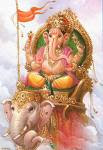On behalf of humanity, Vishnu approached Bhairava and requested him to stop the slaughter. Bhairava said: "I will go on killing until my bowl is filled with enough blood to quench my thirst." It was common knowledge that Bhairava's bowl could never be filled and his thirst never quenched.
His heart filled with compassion, Vishnu addressed Shiva thus: "Let me give you all the blood you need. You don't have to bleed mankind." So saying, Vishnu struck his forehead with his sword and let his blood spurt into Bhairava's bowl. Ages passed, Vishnu kept pouring his blood into the bowl, while Bhairava kept drinking it.
Bhairava finally realized that Vishnu was sacrificing himself for the sake of the world. Moved by Vishnu's generosity, he declared, "So long as you preserve the world, I will not seek to quench my thirst. But when the world becomes so corrupt that even you cannot sustain it, I will raise my trident and squeeze every drop of blood from the heart of man."
In Hindu esoteric imagination, the supreme and ultimate reality is believed to reside in the Universal Soul, which is said to pervade the entire manifested cosmos. The cosmos itself is thought to have evolved from this abstract entity, which is formless and devoid of any qualitative attributes (Skt. Nirguna Brahman). It is neither male nor female, and is infinite, without beginning or end. It is both around us and inside us. The goal indeed of all spiritual practice is to unite with this Supreme Soul.
To the eternal credit of Indian creativity, abstract concepts such as the one above are made intelligible to ordinary mortals like you and me through the invention of various forms which make comprehensible the ultimate, formless reality. Thus the Nirguna Brahmana (Nirguna - without quality) becomes Saguna Brahmana (Saguna - having qualities). This transformed entity is known in Sanskrit as Ishvara.
The entire universe, along with the dynamic processes underlying it, is said to stem from Ishvara. For example, when Ishvara creates the universe, he is called Brahma, when he protects, he is called Vishnu, and when he destroys, he is Shiva. The three together constitute the trinity, which controls the universe and all its functions.
Thus, as exemplified in the above legend, Vishnu is the Preserver, the protector of all humanity. A deity who saves mankind from calamities which result from its own foibles.
Vishnu finds his earliest mention in the Rig Veda, the most ancient book in the world. Here he appears as a solar deity. The Vishnu of the Rig Veda is a manifestation of light, whose head was, by a trick of the gods, severed from his body. This severed head is believed to have become the sun. Further in the Veda, Vishnu is a friend and associate of Indra, god of rain, thunder, and storm. Together, Vishnu the sun and Indra the rain, take on the demon Vritra, who personifies drought. Indra and Vishnu both are described as Vritrahan or the killer of Vritra. This potent combination forms an awesome ensemble of fertilizing powers.
The Vedic connotations of Vishnu are discernable also in the etymology of his name which is derived form the root 'vish' , which means to spread, or in other words all-pervading. Indeed in the Vedas he is the all-pervading sun, whose rays envelop the earth, as does Vishnu himself, in his role as protector of the world.
It is not surprising thus, observing Vishnu's popularity, that he has been a constant source of inspiration for artists down the ages. His visual presentations tend to depict in clearly perceptible terms, all the composite elements which make up this comprehensive deity.
Vishnu is usually depicted with four arms, though sometimes he may even have more than this number. The many arms of Hindu deities are symbolic of the god's manifold powers. Whereas we have limited abilities, a god's power is unlimited, signified by the many hands that hold a variety of attributes and perform myriad activities, often simultaneously. According to noted Indologist Alain Danielou "the image of a deity is merely a group of symbols."
The significance of the Vishnu icon is explained in the Puranas and several minor Upanishads. The two most common representations show him sleeping above the causal ocean on the coils of a serpent, while the other shows him standing with four arms, each exhibiting a different attribute.
By Nitin Kumar of Exotic India Arts,
http://www.religionfacts.com/hinduism/deities/vishnu.htm

